Introduction
We are fortunate to have been given a copy of an unpublished history of Killiney called “Killiney Surroundings”. This work consists of a collection of essays and notes compiled over a period of forty years by the bookseller William Fernsley Figgis, a native of Killiney. The earliest history dating back from the establishment of the Church of the daughters of Lenin in the 6th century is recorded in detail. A number of contributors are named and Charles McNeill (editor of Archisbishop Alen’s Register), is attributed with the following piece.
Pagan and Celtic (extract from chapter 2) by Charles McNeill
Peter Wilson – of whom we shall have more to say in a later chapter – seems to have been the first in modern times to call attention to the Judgment Seat. He was evidently satisfied that it was quite a genuine monument of Druidic times. He called his own house Mount Druid; and subsequently Druid Lodge; Druid Hill, Templeville took their names from it. Wilson also in 1785 invited General Vallancey (who had come over to Ireland before 1770 to assist in a military survey of the county) down to inspect these remains, and it would appear to have been in consequence of this visit that it was designated a Pagan Temple on the first Ordnance Survey map 1837.
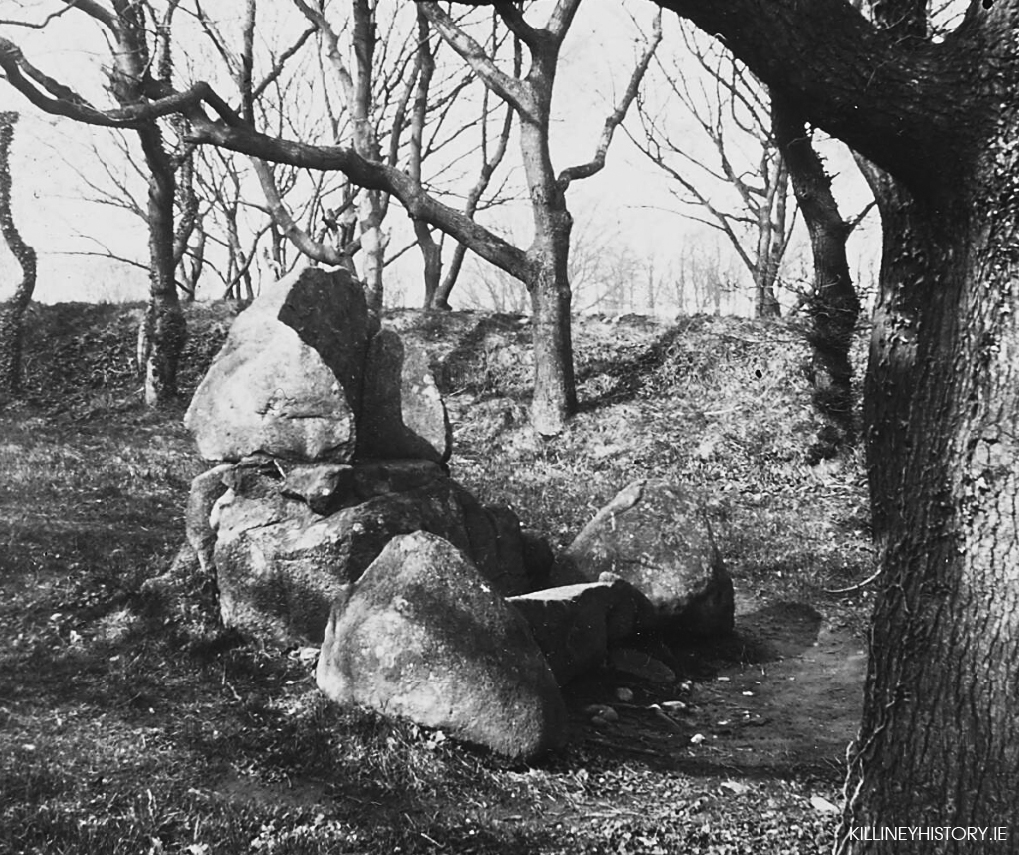
In 1832 we find another reference, when a writer to the Dublin Penny Journal invites attention to ‘A Chair formed of stones, nearly similar to that described as the Coronation Chair of the O’Neills…. when I visited the spot some time since, it lay nearly hid in a clump of dwarf trees, and was completely overgrown with briers.’
John Dalton writing in 1858 seems quite satisfied of the antiquity of the Judgment Seat. The Gazetteer of Ireland states “A well-preserved Druidical circle with its priests’ seat and its sacrificing stone, occur within a carefully kept enclosure, behind Mount Druid demesne, and near the Martello Tower, but is made accessible by the proprietor to respectable visitors.”
William Wakeman, a well known antiquarian of the last century, appears to have been the first to condemn these remains as spurious. (1) “Formerly it was enclosed within a circle of great stones and a ditch. The circle has been destroyed and the ditch so altered that little of its original character remains. The seat is composed of large rough granite
blocks and, if really of the period to which tradition refers it, an unusual degree of care must have been exercised for its preservation. The stones bear many indications of their having been at least rearranged at no very distant time. Smell wedges have been introduced as props between the greater stones. The right arm is detached from the other part, to which it fits but clumsily. The whole, indeed, bears the appearance of a modern antique, composed of stones which once formed a portion of some ancient monument. One great evidence of its being a forgery consists in the position which it occupies near the eastern side of the enclosure, while the back of the seat is turned to the west and towards the centre of the space originally enclosed by the stone circle. The following are its dimensions: Breadth of base 11 ½ feet, depth of the seat 1′ 9″; extreme height 7 feet. Of several detached stones remaining in the enclosure, one is remarkable for the form into which it has been cut. It is a work probably coeval with the original stone circle, and it has been suggested to be symbolical of the sun and moon.’
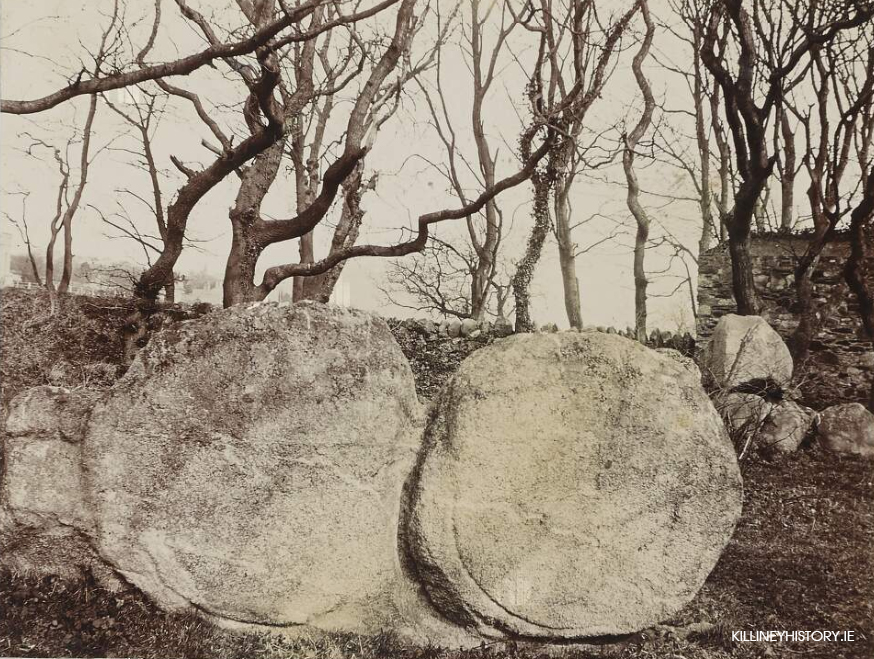
A later (2) account by the same writer adds a few particulars. “There can be no question that the circle anciently contained a monument of some kind, probably a dolmen, or more than one, and that the so-called Druid’s Seat is made up from portions of these ruins. In fact, it presents all the appearance of a mock antique, or what in Ireland is usually styled a ‘folly’. It probably dates from the middle of the last (i.e. 18th) Century, a period during which there was much speculation amongst a certain class of antiquaries concerning Druids and their mysteries, and when it was considered by not a few of the more wealthy gentry good form to establish upon their pleasure grounds a monstrosity of some kind, mock ruins of an abbey or castle, a druidical monument or so forth.’
Elrington Ball confirms this view of the Druid’s Judgment Seat. The stones of which it is composed formed part of a Sepulchral memorial dating from very early times, consisting of three small cromlechs, surrounded by a circle of upright stones about 135 feet in diameter, and, at the time of its first attracting attention, in the 18th Century when everything prehistoric was attributed to the Druids or the Danes, it was assumed to be a Pagan Temple… Near the circle was discovered at the same time an ancient burying place, and some stones with curious markings, which are still to be seen. The burying place was of considerable extent, the bodies, which were enclosed in coffins made of flags, having been laid in a number of rows of ten each.’

Finally Woodmartin makes the sweeping statement, The (3) entire structure leaves the unmistakeable impress of very modern fabrication, and it is a mere clumsy attempt to gull the public.’
As seen to-day these relies of antiquity present rather an unlovely picture, in an obscure and ill-kept corner, surrounded by an unsightly hedge, where weeds and brambles share their ancient sanctity; they seem to arouse but little interest.
The enclosure covers an area of about quarter of an acre. The walls on the east and part of the south side are modern, but the general impression of the corner is one of antiquity. The twin stone of the Sun and Moon has all the appearance of being genuine and of having been undisturbed for long ages.
Concerning the Judgment Seat itself an interesting point arises. Supposing that the adaptation of cromlech stones for its erection in the middle of the 18th Century, as is suggested, it would then have been on the property of that John Mapas who, a little earlier had built the obelisk on Killiney to give employment. Could he have continued his charitable purposes by having this ‘monstrosity’ erected? There is not the slightest evidence of this, and it is improbable, but he certainly would have been very unlikely to countenance anyone else doing so on his property.
In 1785 when Gen. Vallancey visited the scene the forgery must have been recent, and one would suppose that would have been easily detected.
So this old monument remains a mystery, even admitting its modern setting, it seems to regard the sensitive onlooker with a sphinx-like silence and preserves its secret.
(1) Wakemans Handbook Irish Antiquities 1858 p.52
(2) Journal R.S.A.I. 1898 p.411
(3) Woodmartin. Traces of the Elder Faiths of Ireland 1902 Vol 11 p.255
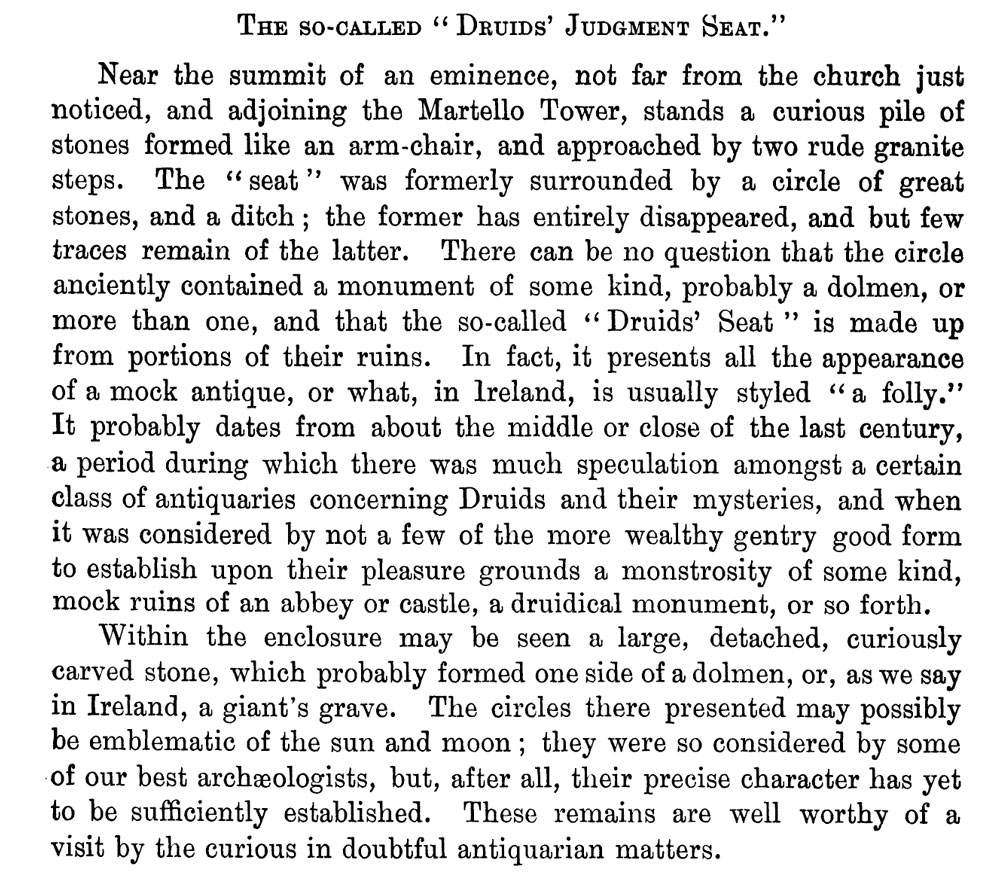
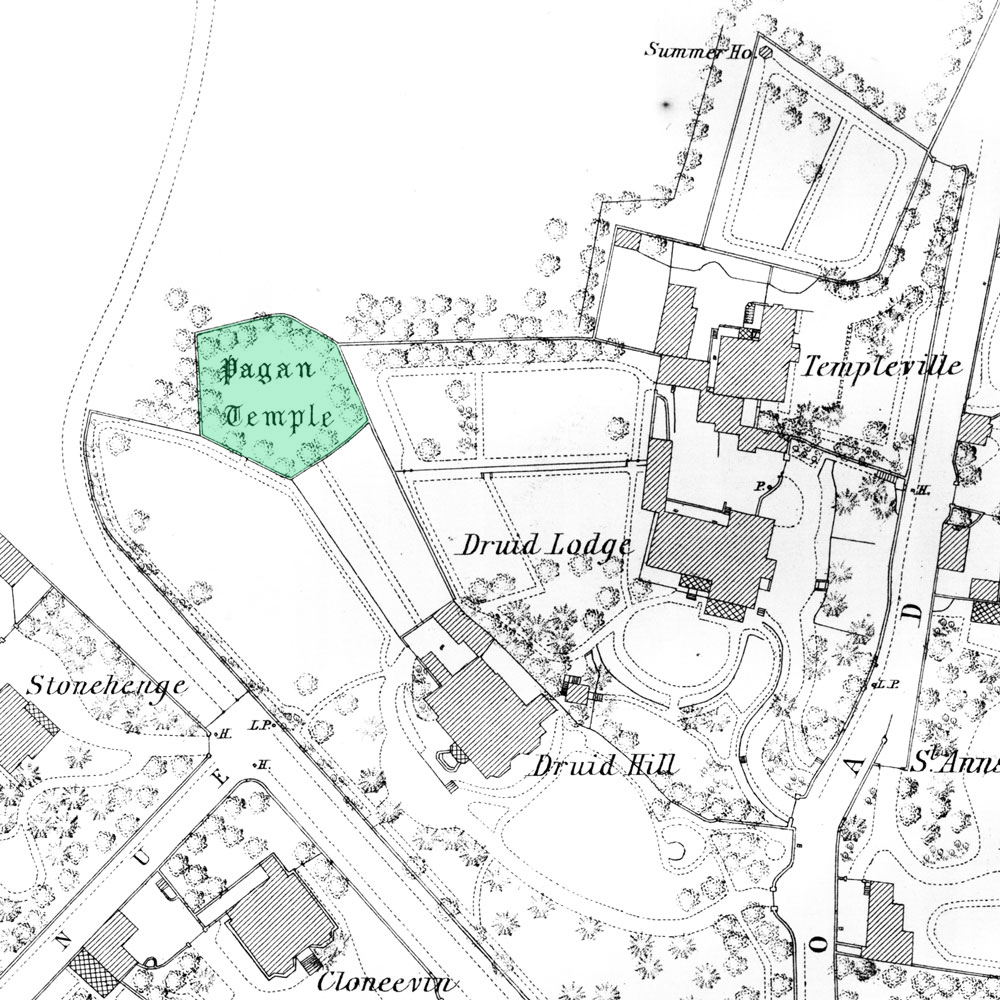
Piece from History of the County of Dublin by D’Alton 1838
Near this hill, at the residence of Mr. O’Hara, in a circular enclosure of stunted oaks, is one of those few remarkable Brehon chairs which yet stand in the island. It presents the appearance of a large arm chair of stone, with a slab step between two large rocks, all of granite. At the distance of a few yards behind it is a screen-like granite slab, standing nearly perpendicular, and pierced about half through, at the side fronting the back of the chair, with a large hole sufficient to admit a man’s forefinger ; this slab is about one yard square. About the same distance behind this is a yet more curious granite slab, about three yards long by one and a quarter high, also standing nearly perpendicular. In the middle of the upper side it is cut down into a long narrow slit, resembling a lengthened horse-shoe; down from which, at one side, it is deeply grooved to the ground, and on the other side but partially and slightly. In this slab are two similar small circular perforations at the side fronting the chair, which is, however, as it were, studiously turned from these other stones, and all are overgrown with moss.
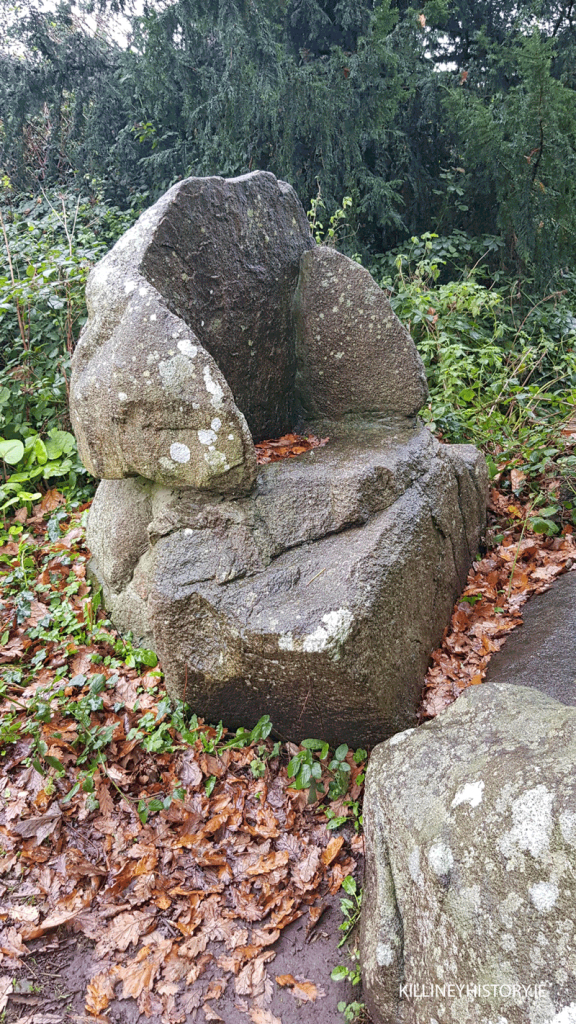
ON THE ORIENTATION OF SOME CROMLECHS IN THE NEIGHBOURHOOD OF DUBLIN. (PART II.) By Professor J. P. O’Reilly, Royal College of Science, Dublin. [Read November 30, 1896.]
In the previous Paper I point out that the Cromlechs of Glen Druid, Shanganagh, and Howth showed distinct evidence of orientation, and that in the case of the first-mentioned, the arrangement of the stones forming the north, south, and west walls of the chamber, seemed to admit of the opinion that the monument had served for the observation of the summer solstice. Encouraged by these results, I was led to examine and make plans and sections of the other cromleachs which exist in the neighbourhood of Dublin; and during the summer months just past was practically able to complete this work. I have now to submit the plans of the Cromlechs of Mount Venus, Larch Hill, and Shankill, with a description of two of the stones forming part of the group known as “Druid’s Chair,” Killiney, as they seemed to me to bear on the general question of the orientation of this class of monument.
Druid’s Chair, Killiney

As bearing on the orientation of the stone just described (Mount Venus), I submit plan of two of the stones forming the group known as the “Druid’s Chair,” Killiney. One of these, the most westerly of the set, presents on its southern face two deep circular incisions which have suggested that they were made with a view of obtaining two mill- stones from this rock. Its upper edge or face is partly fashioned into two circular surfaces, so that the north-eastern side of the rock presents the outline shown in the accompanying elevation. Between this rock and the “Druid’s Chair” lies a single stone somewhat disposed as that just described for the Mount Venus cromlech, and so markedly oriented east and west. At the Druid’s Chair the stone in question has a face practically due north and south (north, 0° 35′ west). There exists thus a due north and south line of direction, and it was to be presumed that means had been secured of determining an east and west line of direction. Now, as a matter of fact, a line drawn from the southern corner of this stone to the south-western corner of the mill-stone rock, gives a due east and west direction.
It would seem therefore that, independently of the direction of the principal parts of these monuments, a means of orientation was attained by the builders or users of them by fixing single stones, either due east and west or north and south, and placing these in relation to other parts of the monument, so that a corresponding north and south or east and west line of direction was determined. As in some way agreeing with this view is the fact that the east and west line determined as mentioned and indicated in the plan is that of the entrance to the present enclosure of the monument, which was formerly surrounded, according to tradition, by a ring of stones with an entrance way, which in all probability, if not certainly, is that still existing.